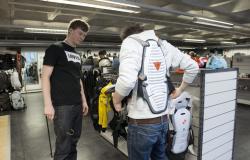Hank Stephenson has a finely tuned lie detector. The longtime journalist made his living debunking falsehoods and political propaganda. But even he was initially fooled when he saw a video of one of the most prominent congressional candidates in his home state.
There was Kari Lake, the Republican candidate for Senate from Arizona, on her cell phone screen, saying words written by a software. Stephenson was watching a deepfake — a video generated by its own information company, Arizona Agenda, to highlight the dangers of artificial intelligence (AI) disinformation in a crucial election year in the US and around the world.
“When we started doing this, I thought it was going to be so bad that I wouldn’t fool anyone, but I was amazed at the end result,” said Stephenson, who co-founded the site in 2021, in an interview. “And we’re not sophisticated. If we can do this, anyone with a real budget can do a good enough job to fool us, they’re going to fool me, and that’s scary.”
As the 2024 presidential election approaches, experts and officials are increasingly sounding the alarm about the potentially devastating power of deepfakes of AI, which they fear could further erode the country’s sense of truth and destabilize the electorate.
There are signs that AI — and the fear surrounding it — is already having an impact on the presidential race. Late last year, former President Donald Trump falsely accused the producers of an ad, which showcased his well-documented public gaffes, of trafficking in AI-generated content. Meanwhile, fake images based on real photos of Trump and other political figures, designed to both boost and hurt them, have gone viral time and time again, sowing chaos at a crucial point in the election cycle.
Now, authorities are trying to find an answer to this problem. In recent months, the New Hampshire Department of Justice announced it was investigating a spoofed robocall featuring an AI-generated voice of President Biden; Lawmakers from Oregon to Florida have passed bills that restrict the use of this type of technology in campaign communications.
And in Arizona, a key state in the 2024 race, the top elections official used deepfakes of himself in a training exercise to prepare the team for the onslaught of disinformation to come. The exercise inspired Stephenson and his colleagues at Arizona Agenda, whose informative agenda seeks to explain complex political stories to an audience of about 10,000 subscribers.
For about a week, they exchanged ideas and had the help of a friend with experience in technology. On Friday, March 22, Stephenson published the article, which included three clips with deepfakes of Lake.
It begins with a ruse, telling readers that Lake — a far-right candidate who Arizona Agenda has criticized in the past — decided to record a testimony about how much she likes the channel. But the video quickly moves to the starting point.
“Subscribe to the Arizona Agenda for hard-hitting real news,” the fake Lake tells the chamber, before adding, “And a look at the risks artificial intelligence will bring in the upcoming election, like this video, which is a deepfake of AI that Arizona Agenda did to show how good this technology is getting.”
Within hours, the videos had generated tens of thousands of views — and a very displeased response from the real Lake team. Her lawyers sent a letter demanding “the immediate removal of the fake videos from all platforms where they were shared or disseminated.” If the media outlet refuses to comply, the letter read, Lake’s campaign “will resort to all legal means available.”
Stephenson said he was consulting with lawyers about how to respond, but was not planning to remove the videos. You deepfakeshe said, are good learning devices, and the journalist wants to arm readers with the tools to spot such fakes before they are bombarded as election season heats up.
“Fighting this new wave of technological misinformation this election cycle depends on all of us,” Stephenson wrote in the article accompanying the clips. “Your best defense is to know what’s out there — and use your critical thinking.”
Hany Farid, a professor at the University of California at Berkeley who studies digital propaganda and disinformation, said the Arizona Agenda videos were helpful public service announcements that seemed carefully crafted to limit unintended consequences. Still, he said, media outlets should be careful about how they frame their reports. deepfake.
“I support advertising, but there is a balance,” Farid said. “We don’t want our readers and viewers to see as false anything that doesn’t conform to their view of the world.”
You deepfakes present two distinct “threat vectors,” Farid said. First, bad actors can generate fake videos of people saying things they never said; and secondly, people may consider with more credibility fake any real embarrassing or incriminating images.
This dynamic, according to Farid, was especially evident during the Russian invasion of Ukraine, a conflict rife with disinformation. At the beginning of the war, Ukraine promoted a deepfake which showed Paris being attacked, urging world leaders to react to the Kremlin’s aggression with the same urgency as they would if the Eiffel Tower had been hit.
It was a potent message, Farid said, but it opened the door to Russia’s baseless claims that subsequent videos from Ukraine showing evidence of Kremlin war crimes were similarly false.
“I worry that everything is becoming suspicious,” he said.
Stephenson, who lives in a political battleground that has lately become a convergence of conspiracy theories and false allegations, has a similar fear.
“We have been debating for many years about what is real,” he said. “Objective facts can be considered fake news, and now objective videos will be considered deep fakes, and deep fakes will be treated as reality.”
Researchers like Farid are working feverishly on software that allows journalists and others to more easily detect forgeries. Farid said the toolset she currently uses easily classified the Arizona Agenda video as fake, a hopeful sign for the next wave of fakes. However, the technology deepfake is improving at a rapid pace and future counterfeits could be much more difficult to detect.
And even the deepfake of Stephenson, admittedly of low quality, managed to fool some people: After sending the newsletter with the headline “Kari Lake Do Us a Favor”, a handful of subscribed readers unsubscribed. More likely, Stephenson suspects, they thought the support for Lake was real.
Exclusive PÚBLICO/The Washington Post
Tags: Deepfake Republican candidate shows risks elections Artificial intelligence
--





